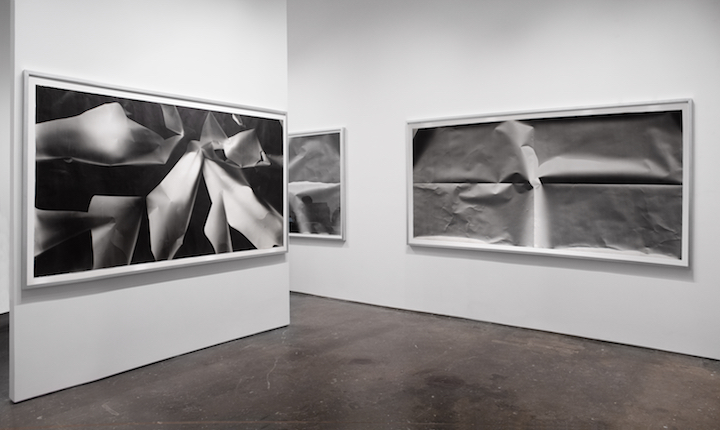At first glance, the idea of making photographs without using a camera is altogether counterintuitive. For most of the artists who wander down this path, the darkroom essentially becomes their art making device, and in particular for those interested in photograms, the enlarger or whatever light source is being used to activate the process. By its very nature, working in the dark (so as not to inadvertently expose the light sensitive paper) inherently introduces elements of chance, misalignment, and improvisation, which many artists find liberating and inspirational. But mostly, the camera-less approach tends to make the photographers who use it highly sensitive to the properties and possibilities of light, as light is the engine of their expressiveness.
Sheila Pinkel’s Folded Paper works from the 1970s and early 1980s are iterative studies in the complex physics of light. In each work, Pinkel combines folded or gently crumpled papers with directed light sources, and with each experiment, the surfaces and planes of the paper have been exposed differently, ultimately leading to flat two dimensional representations of how the light bounced off and settled onto the original three dimensional forms. Her works in this project range from elegantly simple and elemental (made from just a single fold or two) to much more dramatic and explosive (when the whole surface was bent and crumpled), each resulting object print combining the nuances of the cast light with the real physical folds of the underlying process.
The first thing that visitors to this show will notice is the scale of these works – at roughly 4 by 9 feet each, they are truly immense for the time in which they were made. The paper itself must have come in a roll, but how Pinkel wrangled the cut sheets through some extra wide developer tray without having the chemicals create pools and washes on the surface is an impressive mystery. Pinkel also made much smaller versions of her folded paper experiments, so these extra large works were clearly tests of the limits of her process and of what the light would do when given more room to run.
The next visual discovery to be made is that the tones are reversed in these works – the areas that read white are the ones where the darkest hollows and shadowed patches were created by the folds and crumples, and those that now read black were where the light caught or gathered the most. This inversion is altogether disorienting, at least for those of us that like to try to puzzle out what is happening; a folded area that is white is actually a dark gutter not a bright corner. The switch makes it much harder to try to imaginatively recreate where the light came from or what the original form might have looked like, making the works all the more perplexing.
Two of the large works follow the pattern of two geometric folds in half, which divide the paper into quadrants. From there, gentle billows, puckers, and undulations in the paper add to the complexity of the surface the light interacts with. The results are sophisticated and sculptural, with each fold unlocking a range of subtle shifts in silvery grey. At such large scale, each tiny ripple and fold becomes gestural, the gradations of light falling across the surface with sublime refinement. A third large work turns the volume up significantly, seemingly encouraging the paper crumples to blast from the surface of the paper. The contrasts of light and dark in this work are more pronounced, and the folds less gridded and geometric, leading to a more passionate and looser composition that reaches energetically toward its edges, the vibrancy of its gestures feeling almost painterly.
Two smaller works use denser clusters of folds to create complexities for the cast light. These prints are executed in the sinuous blue of cyanotype, on richly textured paper, once again reversing the tonalities so dark areas in the prints represent zones and highlights that received the most light (not the least). Their folds echo the repeating pleats of fans or the gridded lines of origami tessellations, the additional bends and breaks in the paper creating more opportunities for highlights and contrasts than in Pinkel’s more elemental compositions. The ordered geometries of these works feel like a nod to Minimalism, that is until the tactile grace of the tonal gradations of blue draws us under its spell.
While Berenice Abbott did scientific studies of light (and made painstaking technical images of her results) during her time at MIT in the 1950s, Pinkel’s work in the 1970s feels more searchingly open ended. Barbara Kasten also made large scale cyanotypes of surfaces, often tightly woven mesh, during roughly the same period, but her works feel less about the properties of light and more about painterly washes and layered transparency. And in recent years, artists like Walead Beshty and Mariah Robertson have pushed further, exploring the properties of additive color within this framework of camera-less experimentation. But the universe of artists who have systematically explored light as deeply as Pinkel is relatively small.
While photographic folded paper studies (of the art school variety) can sometimes feel simplistic and routine (they are teaching tools after all), there is nothing simple about Pinkel’s massive works. These are the kind of works that fascinate at different distances, from nose-to-the-frame examinations a viewer can get lost in to the view at ten (or twenty) feet which feels majestically grand and impressively expansive. There is a richness and intelligence to these big “Pinkelgraphs” that feels eminently durable, giving them the opportunity to surprise us, even after we have made them familiar.

